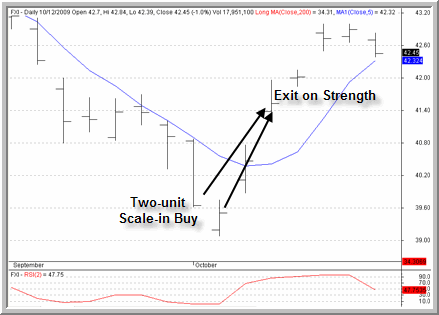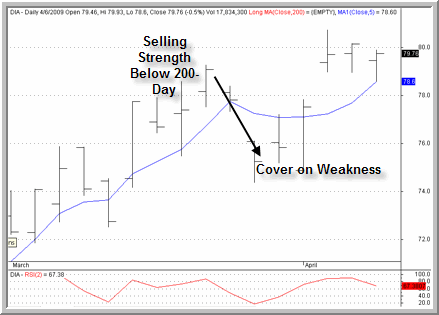High Probability Trading Strategies and Resolutions for the New Year
If your list of New Year’s resolutions isn’t long enough, here are a few special resolutions for high probability traders for 2010. Keep these rules and resolutions in mind when looking for the best stocks and exchange-traded funds (ETFs) to trade each day and you’ll have some of the biggest quantified short term edges on your side every time.
1. I will only buy stocks or exchange-traded funds when they are trading above the 200-day moving average.
Below is might be the most important chart for short term traders over the last few years. Our research, going back to the 1990s, shows that buy only buying stocks or ETFs when they are above the 200-day moving average, traders can trade with the wind at their backs, rather than in their faces.
2. Short term lows outperform short term highs. I will buy pullbacks rather than breakouts.
Our research on this point is no secret. And I think more and more traders are recognizing this fact, however difficult it can be to adopt in you’re their own trading (this, by the way, is one reason Stock PowerRatings and ETF PowerRatings can be helpful for traders new to high probability trading strategies).

There are a wide variety of ways to take advantage of the data that shows short term highs in stocks and ETFs outperforming short term lows. From buying 5, 7 or 9 day closing lows, to scaling-in to positions based on exceptionally low 2-period RSI readings, the goal of the high probability trader remains the same: buy the selling.
3. When I buy on weakness, I will always exit on strength.
An old trader acquaintance of Larry Connors once remarked, “when the ducks are quaking, feed them.” That’s the attitude of the high probability trader when it comes to exiting short term trades. Having bought stocks or ETFs that have been put on sale by profit-taking and, typically, panic selling, the high probability trader looks to sell those same stocks or ETFs when demand picks back up, often driving those oversold stocks and ETFs significantly higher in a short period of time (less than 5 to 7 days).
4. I will be ready to learn new tactics and strategies to improve my trading.
There are always new discoveries and new insights into old trading methods and the professional trader – and certainly the high probability trader – is always open to anything that will help make his or her trading business more successful. Whether that is subscribing to or following a new trading blog, taking a professional trading course like the TradingMarkets Swing Trading College, or simply adding a new facet – like high probability trading – to your current trading business, why not do everything you can to make 2010 your best trading year yet?
5. I will develop my trading plan for the year and stick with it. I will not be distracted by the media, politics, or the hype.
Rocker Elvis Costello had a line, “I used to be disgusted/Now I try to be amused.” Keep that in mind the next time you hear someone screaming about something in the financial media or see someone finger-wagging in front of the cameras in Washington.

High probability trading strategies have been backtested going back to the mid-1990s and through all the scandals and upheavals, the robustness of high probability trading remains: consistent win rates in excess of 75% in stocks and exchange-traded funds using a variety of mean reversion-based, high probability trading strategies.
The record of Larry Connors’ Battle Plan, for example, 42 out of 52 correct since October 2008 is a more recent testament to what high probability strategies can accomplish when traded in a consistent and disciplined fashion.
On behalf of TradingMarkets, I want to wish you and yours a very Happy New Year. TradingMarkets will be here every day for you in 2010, doing everything we can to help make you the best trader you can be.
David Penn is Editor in Chief at TradingMarkets.com.
